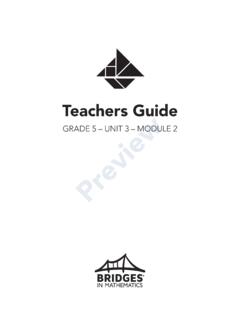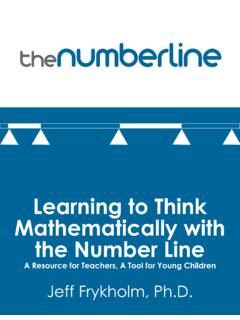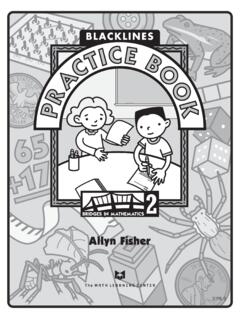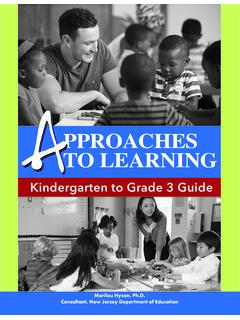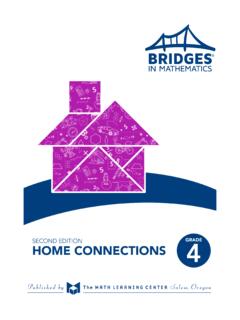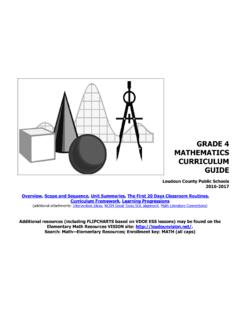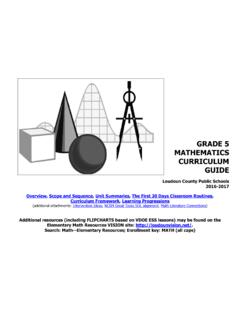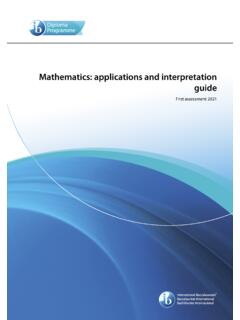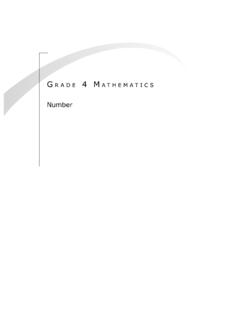Transcription of Bridges in Mathematics Grade 5 Unit 2 Module 3
1 Teachers GuideGRADE 5 UNIT 2 Module 3 PreviewPreviewSession 1 Buying Granola 3 Session 2 Fractions Are Ratios 7 Session 3 Working with Fractions Checkpoint 15 Session 4 Fraction Strategies Poster 19 Session 5 Common Denominators 23 Session 6 Unit 2 Post-Assessment 29 Module 3 Common DenominatorsTeacher MastersPages renumber with each Pounds of Granola T1 Working with Fractions Checkpoint T2 Unit 2 Post-Assessment T4 Student Book PagesPage numbers correspond to those in the consumable Granola 50 Buying Apples 52 Ratio Tables
2 53 More Ratio Tables 55 Fraction Story Problems 56 Ratio Tables to the Rescue! 57 Adding Fractions & Mixed Numbers 58 Fraction Addition & Subtraction Review 59 More Fraction Problems 60 Home Connections PagesPage numbers correspond to those in the consumable a Ratio Table 31In the Library 33 Fraction Addition & Subtraction Story Problems 35 The Math Learning Center | in Mathematics Grade 5 Teachers GuidePreviewPreview The Math Learning Center | in Mathematics Grade 5 Teachers Guide1 Unit 2 Module 3 Common
3 DenominatorsOverviewIn this Module , students compare the ways they have used ratios tables to solve problems and discuss the operations that work in a ratio table. In Session 3, students solve addition and subtraction story problems using a variety of strategies, which they share and compare in the next session. In Session 5, they make generalizations about finding common denominators to add and subtract fractions. The Module ends with the Unit 2 & Work Places IntroducedP&IPSMFWPADPHCS ession 1 Buying GranolaThe class works together to investigate buying different amounts of granola when granola costs $6 for 5 pounds After an initial discussion, students work in pairs to find the cost of various amounts using ratio tables The teacher reconvenes the class to compare and discuss strategies The discus-sion culminates with an error analysis and then a generalization about the operations that can (and cannot)
4 Be allowed in ratio tables Session 2 Fractions Are RatiosThe teacher leads a discussion with the class to generate a chart showing how they have been using ratio tables to solve problems The teacher then points out that fractions are a type of ratio, so students can use ratio tables to find equivalent fractions in order to add and subtract fractions The class uses a ratio table to find equivalent fractions and to simplify fractions, and then students complete a related assignment in their Student Books When they finish, students visit Work Places if time allows Session 3 Working with Fractions CheckpointStudents take a checkpoint based on their work with fractions Then they solve fraction story problems that will be discussed in Session 4 Session 4 Fraction Strategies PosterIn this session, students discuss the strategies they used to solve the fraction addition and subtraction story problems from the previous session As they share, the teacher makes a poster of their strategies Students spend the remaining time visiting Work Places Session 5 Common DenominatorsIn this session.
5 Students make generalizations about finding common denominators in order to add and subtract fractions Then they spend the remainder of the session visiting Work Places Session 6 Unit 2 Post-AssessmentStudents take the Unit 2 Post-Assessment and then visit Work Places P&I Problems & Investigations, PS Problem String, MF Math Forum WP Work Place, A Assessment, DP Daily Practice, HC Home ConnectionUnit 2 Module 3 Preview The Math Learning Center | in Mathematics Grade 5 Teachers Guide2 Unit 2 Module 3 IntroductionMaterials PreparationEach session includes a complete list of the materials you ll need to conduct the session, as well as notes about any preparation you ll need to do in advance. If you would like to prepare materi-als ahead of time for the entire Module , you can use this to-do s kDoneCopiesRun copies of Teacher Masters T1 T6 according to the instructions at the top of each master Run a single display copy of Student Book pages 50 51, 53 54, and 56 If students do not have their own Student Books, run a class set of Student Book pages 50 60 If students do not have their own Home Connections books, run a class set of the assignments for this Module using pages 31 36 If you ve run out of clock faces strips (made from the the Clock Faces Teacher Master in Unit 2, Module 1, Session 5)
6 , run additional copies and cut the sheets apart into strips ChartsWrite the title What We Can Do with Ratio Tables at the top of a large sheet of chart paper for Session 2 Write the title Fraction Addition & Subtraction Strategies at the top of a large piece of chart paper for Session 4 Additional ResourcesPlease see this Module s Resources section of the Bridges Educator site for a collection of resources you can use with students to supplement your instruction Preview The Math Learning Center | in Mathematics Grade 5 Teachers Guide3 Unit 2 Module 3 Session 1 Buying GranolaSummaryThe class works together to investigate buying different amounts of granola when granola costs $6 for 5 pounds After an initial discussion, students work in pairs to find the cost of various amounts using ratio tables The teacher reconvenes the class to compare and discuss strategies The discussion culminates with an error analysis and then a generalization about the operations that can (and cannot) be allowed in ratio tables Skills & Concepts Relate strategies for computing with decimals to hundredths to written methods (5 NBT 7) Solve story problems involving division of whole numbers with fraction or mixed number quotients (e g , 3 4 = 3/4) ( 5 NF 3) Make sense of problems and persevere in solving them (5 MP 1) Model with Mathematics (5 MP 4)
7 MaterialsCopiesKit MaterialsClassroom MaterialsProblems & Investigations Buying GranolaSB 50 51* Buying GranolaTM T1 Nine Pounds of GranolaHome Connection HC 31 32 Using a Ratio TableDaily Practice SB 52 Buying ApplesHC Home Connection, SB Student Book, TM Teacher Master Copy instructions are located at the top of each teacher master. * Run 1 copy of these pages for will model strategies on ratio tables today You can draw a new ratio table each time on the board or on blank paper under a document camera, or you can make extra copies of the Buying Granola Student Book page to use Unit 2 Module 3 Session 1 Preview The Math Learning Center | in Mathematics Grade 5 Teachers Guide4 Unit 2 Module 3 Session 1 Problems & InvestigationsBuying Granola1 Begin the session by telling students that today they will work together to investigate the prices of different amounts of Introduce a granola buying scenario that involves the class buying granola to sell as a fundraiser.
8 Five pounds of granola cost $ Ask students to determine how much 11 pounds of granola would cost. Have students think privately of a strategy, then share strategies with a the two strategies described below, and model them on ratio tables. If students do not suggest these strategies, share them yourself. Strategy 1: Double 5 pounds for $6 to get 10 pounds for $12. Divide $6 by 5 pounds to get $ for 1 pound. Add the 10 pounds to the 1 pound to get a combined price of $ for 11 $6$12510pounds 2 2 5 5price$6$12051poundsprice$6$12$120$12 + $12010 + 1$ Strategy 2: Divide the 5 pounds for $6 by 5 to get 1 pound for $ Multiply the l pound by 10 to get 10 pounds for $12. Add the 10 pounds to the 1 pound to get a combined price of 11 pounds for $ $6$12$ $ + $121 + 10$1320510111pounds 5 5price$6$12$1205101pounds 10 10price$6$1205$12101pounds4 Have students turn to the first Buying Granola Student Book page as you display your copy.
9 Explain that they need to find the prices for the amounts of granola listed and use ratio tables to show their Make sure students understand the initial rate (5 pounds cost $6) and that you want to find the cost of other amounts. Use gestures, pictures, and a language partner if avail-able. Emphasize that students can find the amounts in any Work through the strategies for finding the price for 11 pounds again if neces-sary. Encourage students to look for helpful relationships as they work. Help students choose which amount to look for first by asking them to think of ways they can manipu-late the amounts you have so far: 1 pound, 5 pounds, 10 pounds, 11 pounds. If needed, as students verbalize their strategies, write the numbers in the ratio tables with arrows to model their thinking.
10 Suggest that students just start by finding amounts they can, and then use those to help find others that seem too difficult right now. CHALLENGE Encourage students to be thoughtful about the order they choose. How can they be the most efficient? Which answers can help find other answers?About This SessionUntil now, students have worked with ratio tables where the ratio is 1 to something, a unit rate For example, 1 ball costs $15 In today s session, students start with a non-unit rate: 5 pounds of granola costs $6 One of the goals of the lesson is for students to learn to find the unit rate and use it to find other rates For example, students can divide five pounds for $6 by 5 to get one pound for $1 20, a rate of $1 20 per pound They can then double this rate to get the price of $2 40 for 2 pounds A second goal is for students to realize that they do not have to find the unit rate to find many other equivalent rates For example, to find the price for 10 pounds.



